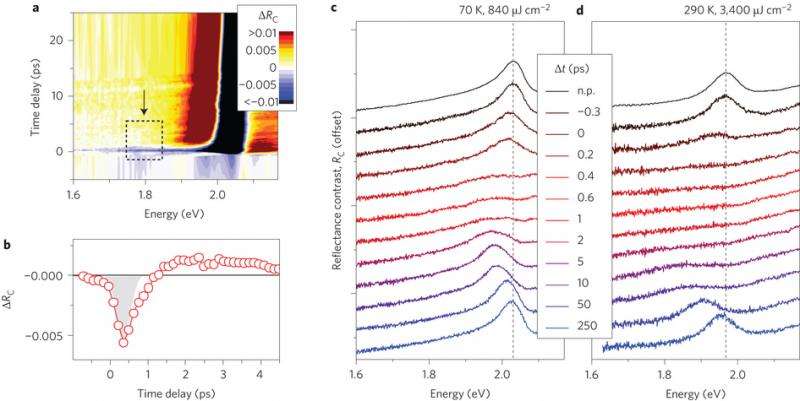June 25, 2015 report
Researchers successfully control optical response of atomically thin materials on short timescale

(Phys.org)—A team of researchers with member affiliations to Columbia and Stanford Universities has found a way to control the optical response of atomically thin materials on extremely short timescales. In their paper published in the journal Nature Photonics, the team describes their approach and why they believe it could help in the development of photonic devices.
As part of their efforts to better understand transition metal dichalcogenides (TMDCs go from being indirect bandgap semiconductors when found in bulk to direct bandgap semiconductors when reduced to one or two atom thick samples and can be used to create films useful in optical applications) the team looked to 2D samples of tungsten selenide to help provide answers. TMDCs are denoted by the structure, MX2, where M is a particular transition metal and X is a chalcogen, thus tungsten selenide, is WS2.
The team subjected one-atom and two-atom thick samples of the material to very short laser blasts, noting the photo response over a wide range of frequencies. Doing so, the researchers note, caused the material to absorb excited charge carriers, which caused the material to act in some ways like a metal. The carriers, they also note, changed the character of the excited states—during times of high excitation, the charges canceled one another, leaving plasma that was free of electrons and holes, aka a Mott transition—an example of a controlled optical response. In the absence of such high excitations, an exciton is normally created due to the attraction of the carriers.
Mott transitions in TMDCs are central to research involving many-bodied physics, and other researchers will likely take note of the fact that it is now clear that at least one type is able to withstand the onslaught of rapid laser pulses—it suggests them for possible use in solar cells or other applications where a material will be subjected to harsh conditions.
The team believes their findings could lead to advances in flexible displays, making them cheaper to produce and also in various other electronic devices. They plan to continue their work, hoping to learn more about how electrons in such materials interact.
More information: Population inversion and giant bandgap renormalization in atomically thin WS2 layers, Nature Photonics (2015) DOI: 10.1038/nphoton.2015.104
Abstract
Control of the optical properties of matter on ultrashort timescales is of both fundamental interest and central importance for applications in photonics. It is desirable to achieve pronounced changes over a broad spectral range using the least possible amount of material. Here, we demonstrate a dramatic change over a spectral range of hundreds of meV on the femtosecond timescale in the optical response of atomically thin two-dimensional crystals of the transition-metal dichalcogenide WS2 following excitation by intense optical pump pulses. Our findings reveal the role of extremely strong Coulomb interactions. At the direct gap, we observe a Mott transition from excitonic states to free carriers, accompanied by a giant bandgap renormalization of approximately 500 meV and the development of population inversion.
Journal information: Nature Photonics
© 2015 Phys.org

















